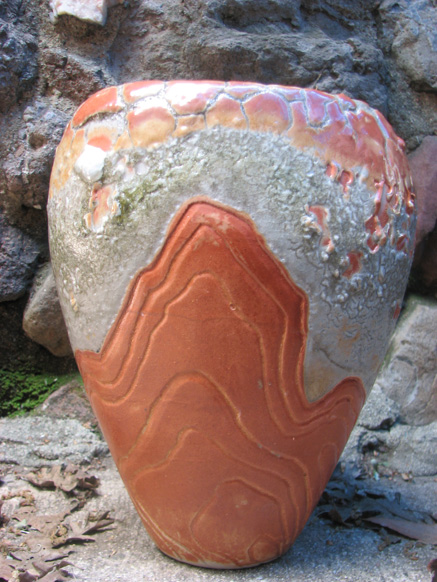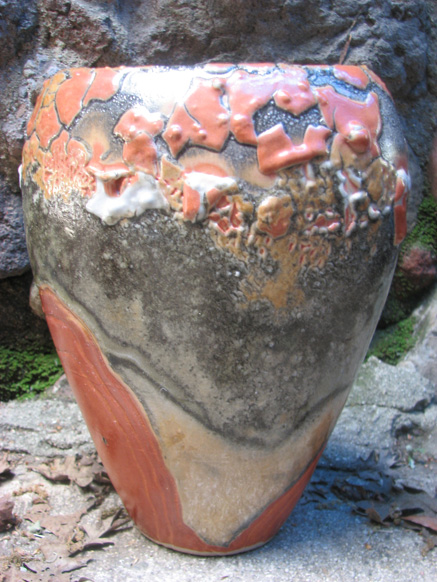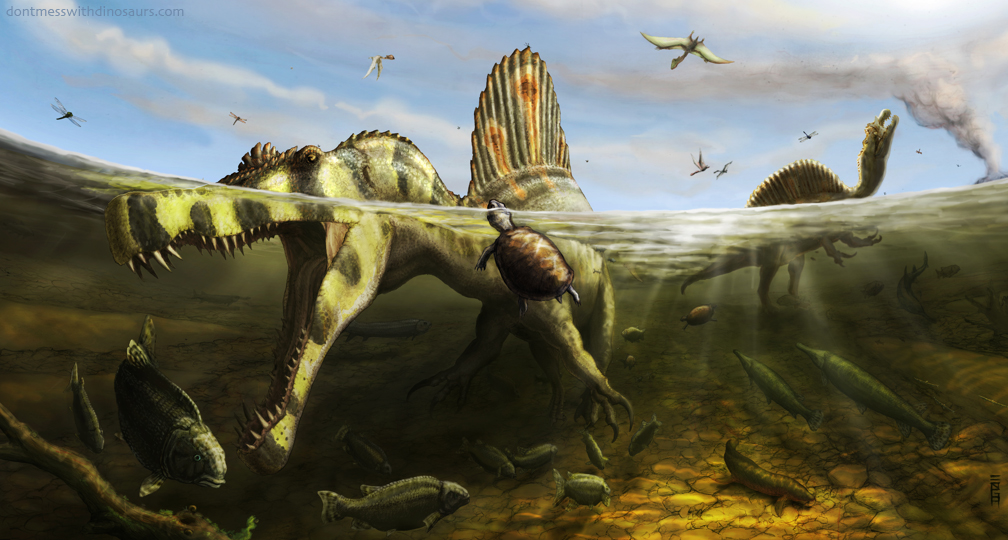Archive for the 'paleo art' Category
Armatures
It occurred to me that it might be cool to make dinosaurs out of different ceramic clays and fire them unglazed so that the natural texture of the clay gives the dinosaur its scales, while at the same time being raw and geological.
So, I’m trying to do that.
I just finished the wood/paper armatures. An armature is any structure made to support soft clay from within. In this case ceramic clay will be built up around the wood. The wood will provide the clay the support it needs until it dries and can support itself. Once it has dried it will be fired and the wood will burn out, leaving the form partially hollow.
I’m dong a Parasaurolophus cyrtocristatus. Ever since I was a kid I loved Parasaurolophus tubicen, but I think the smaller crest on the cyrtocristatus species would be less likely to get broken when the clay dries. I’m planning on doing the Parasaurolophus in a fine grain clay, possibly a porcelain, partially because I think they’re really elegant looking animals, and partially because it is known from fossil skin impressions that Parasaurolophus had fine granular scales.
I’m also doing a Majungasaurus. I love how gnarly and mug-faced the Abelisaruids are and I think their super short forelimbs might also stand a better chance of surviving drying and firing than the more elongate forelimbs of other theropods. I chose Majungasaurus because I think all the weird knobs and horns and mangled boney protrusions on Majungasaurus’ skull will make a lot of sense sculpted in a coarser clay with lots of sand and chunks and mineral impurities in it.
Anyway, I’ll post updates as these guys come to life. I love the transformation that occurs when a clump of wet clay takes form, dries, is fired, stained/glazed and is then re-fired at high temperature to crystalize and turn to stone. I’ll do my best to share that transformation with you.
PREHISTORIC TARPON ATTACK!!!!!


Kem Kem revisited: Cladocyclus pankowskii predates on Diplomystus sp. as undescribed Lepidotes(?) forage for aquatic snails on the bottom. Illustration by Brian Engh.
Did you know that you can buy undiscovered species online?
This piece was commissioned by Mark Pankowski. He buys unusual fossils from fossil dealers and donates them to museums for scientific description. If it weren’t for him the big terrifying fish at the top of the illustration (Cladocyclus pankowskii [named after him!]), and the big ugly fish foraging for snails on the bottom (Undescribed species, possibly Lepidotes sp.) might never have been known to science. Turns out, huge numbers of rare fossils are sold to collectors all the time, and many of them are undescribed or scientifically significant.
Mark found out about me from my Spinosaur illustration which features two Cladocyclus pankowskii. Can you find them?
HINT:

When I did the spinosaur illustration only Lepidotes’ distinctive scales were known from the Kem Kem beds of Morocco (where Cladocyclus pankowski and Spinosaurus aegyptiacus are found), so I reconstructed the Lepidotes referencing the european species L. maximus. The fish featured foraging on the bottom in the new illustration for Mark is based on skull material form the Kem Kem that Mark recently donated and is awaiting description… and it looks very Lepidotes-like. If indeed it is Lepidotes, then it is probably the same species as in the Spinosaur illustration.
If only I’d done the Spinosaurus illustration a few months later!!
Gallery Show!!
Sinraptor dongi life restoration/head detail. Pencil on paper (to be colored digitally)
I meant to post on this a little while back when my plans became official, but I got carried away drawing and I didn’t. Anyway, I’m doing my first gallery show…
and it’s all paleo-art.
That means don’t mess with dinosaurs. In an art gallery.
The show is in September so I’m taking most of the summer off to draw dinosaurs and other paleo-monsters pretty exclusively. The gallery is called “The Bone Room Presents” and it specializes in natural history art. It’s located in Berkeley California, so if you’re in the area between the dates of September 2nd to October 5th I hope you’ll stop by. In the meantime, I’ll try to keep up with regular posts of rough sketches and finished pieces as I work through them. Here’s a rough layout of an illustration I’m doing of a Shunosaurus defending its young from some basal Sinraptorid theropods (“Schezuanosaurus zigonensis?”):

The big tree on the left will be a Ginkgo yimaensis, once it is fully rendered. The big weird things hanging from the ginkgo’s branches are called “chichi” (breasts) in Japan. Very ancient ginkgos get them and I thought it would be cool to draw a huge gnarly ancient tree… With breasts.
Anyway, I’m aiming to finish between 10 and 14 new full color illustrations, and I will be showing both the pencil on paper originals as well as prints of the digitally colored finished pieces. I’m in contact with a few paleontologists too, and they’ve been really helpful giving scientific feedback on some of my rough sketches. In that regard, I’m sort of in a ‘pre-production’ phase right now, doing tons of research, amassing reference and getting feedback from experts on my rough sketches in the hopes that everything I produce is as scientifically accurate as possible.
Speaking of which… if you are a scientist who is interested in having a life restoration done for a species you’re working on (or you know of a colleague, friend or enthusiast who is) don’t hesitate to get in touch with me either by leaving a comment or by emailing me directly
(preferred). I figure it’s more worth my time to produce a series of illustrations that will both be seen in my show as well as serve another purpose, scientific or otherwise. Take this piece for example:
I’m just finishing up this commission for a fellow named Mark Pankowski. He donated the type fossils of the fish at the top to the Smithsonian. The Smithsonian then sent the fossils off to Dr. Peter Forey at the Natural History Museum in London. When he determined that the fossils represented a new species of prehistoric tarpon of the genus Cladocyclus, he honored Mark’s contribution to science by calling it Cladocyclus pankowski. The pencil on paper original and a colored print will go to Mr. Pankowski, and another color print will be shown at my show in September. The colored version is very close to finished and I’ll be posting it very soon.
Thanks for checking in! If you want to leave some critical feedback or if you just want to nerd-out about your favourite prehistoric monsters, I encourage you to leave a comment. Or like, five. I get way amped when I get comments.
Seriously. I draw all day and I don’t get out much.
Spinosaurus aegyptiacus – Kem Kem Assemblage
Spinosaurus aegyptiacus with jaws agape trawls for mesozoic fish. Reconstruction of the Cretaceous ecosystem recorded in the Kem Kem beds of Morocco. Illustration by Brian Engh under the scientific guidance of Tor Bertin.
The big gnarly looking fish in the foreground are of the genus Lepidotes, reconstructed based primarily on L. maximus. These fish had rows of flat peg shaped teeth adapted for crushing mollusks, and the one foremost in the frame is eyeing an aquatic snail grazing on the algae-covered driftwood. In the background a couple large predatory tarpon (Cladocyclus pankowskii) can be seen gliding along stealthily. In the foreground observing everything is a giant side-necked turtle (Galianemys whitei). Further back in the frame, swimming around the Spinosaur’s hip area are some small fish that we shall say are of the genus Diplomystus. Between the two spinosaurs another Galianemys swims. In the foreground in front of the background Spinosaur a lungfish (Ceratodus humei) patrols the bottom for molluskan prey, ambling along on its leg-like fins. Just right of the lungfish two large cretacious gar of the genus Oniichthys survey their domain. Way in the back just to the right of the background Spinosaur, a school of Lepidotes and a sawshark (Onchopristis numidus) flee in the wake of the Spinosaur’s piscivorous predation. In the air above the Spinosaurs flies and dragonflies buzz about as Tepejarid and Siroccopteryx/Coloborhynchus pterosaurs soar majestically above.
I did this illustration for a paper being published by a paleontologist named Tor Bertin. It was super exciting to work with a scientist on a paleo illustration for the first time. He provided me with the science that made reconstructing this environment possible as well as the grounding to keep my imagining of these animals vibrant and believable without becoming overly speculative or sensational.
Obviously Spinosaurs are really weird looking dinosaurs, so for this illustration I was attempting to imagine them in a behavioral routine that made sense of their very strange anatomy. It is clear from spinosaur teeth and jaw structure that they have adaptations specific to catching fish, and there is evidence in their bone chemistry that Spinosaurs spent much of their time submerged in water. Also, it appears that spinosaurs had pressure sensing pores in their jaws, similar to crocodiles. These pores allow crocodiles to hunt by sensing the movements of fish in the water around their jaws. All that makes sense for a fish eating predator… So why a huge sail?
The best I can do here is speculate based on the observable behavior of extant animals. It occurred to me that crocodiles, grizzly bears (particularly when hunting salmon runs) and hippos might be good analogues for Spinosaur behavior. All are large, territorial animals that spend some (bears), most (hippos), or nearly all (crocodiles) of their time in rivers. As a result they all do a lot of territorial posturing to defend their stretch of the river. Bears, bellow and stand on their hind legs, hippos vocalize, raise their head and bear their tusks, and crocodiles do a lot of subtle body posturing with their back and head, as well as some vocalization. Of course with crocs a lot of these behaviors are more subtle because stealth above the water is key to their predatory success. Spinosaurs don’t appear to have been well equipped for killing anything other than fish, so a huge display structure above water wouldn’t have hindered their success as hunters. Rather, it might’ve allowed them to broadcast their body language further while at the same time keeping those sensitive fish-trap jaws down in the water hunting. It could also have helped display to mates. In all, it would’ve allowed Spinosaurs to communicate with body language above the water, while still actively hunting below the water. This would’ve increased food intake and decreased combative encounters while at once helping to attract mates. All of which would’ve contributed to greater survival for the individuals with big beautiful communicative sails.
That’s what I was thinking when I drew this, anyway… Let me know what you think.
Thanks for stopping by!
Progress
So this is what I’m trying to finish today:

I need to finish coloring it. Its actually much closer to finished than what you see here, but I didn’t feel like putting up a partially colored version.
Also I (finally) finished this pair of vases (pictures are of front and back):




The one on the right came out exactly as I intended. The other split slightly in the front, but the same glaze did some different neat things because it was in a different part of the kiln…I suppose I’m happy with them… There’s always unpredictability in ceramics.
These were a commissioned gift for a relative. I do commissions whenever I can, and I will be selling a variety of handmade things, from ceramic art, to dmwd t-shirts, and prints of my illustrations (such as the spinosaur illustration above) on my Etsy page. Also if you ever see something up on this site that you like that I haven’t put up on my etsy page, feel free to contact me directly.
Maiasaura Doodle
This doodle makes me happy.
I’m not typically happy with my quick sketches of dinosaurs for both aesthetic and scientific reasons, which is why most of what I am willing to share on the web are detailed pencil renders drawn with careful attention to whatever images of skeletal material I can get my hands on. ^This is an exception. I was just doodling, and this came out, which is satisfying because it’s a pretty good sign that I’m finally developing an instinctive sense of reasonably accurate proportion and posture for ornithopod dinosaurs.
Speaking of proportion and posture, this Maiasaura just spotted a predator and is falling into a bipedal run from an upright “lookout” posture. The funny horn on it’s head is my own interpretation of some small bony extensions on the skull of Maiasaura. Typically this projection is not enlarged in reconstructions, but I think it is entirely plausible, if not likely, that small (presumably) ornamental structures seen in the skeletons of dinosaurs supported much more elaborate soft tissue or horn structures when the animal was alive. If you take a look at the skulls of birds or reptiles with casques or horns or crests, there is a pretty substantial amount of horn and soft tissue attached to the bone. Also, I think it looks cool!









